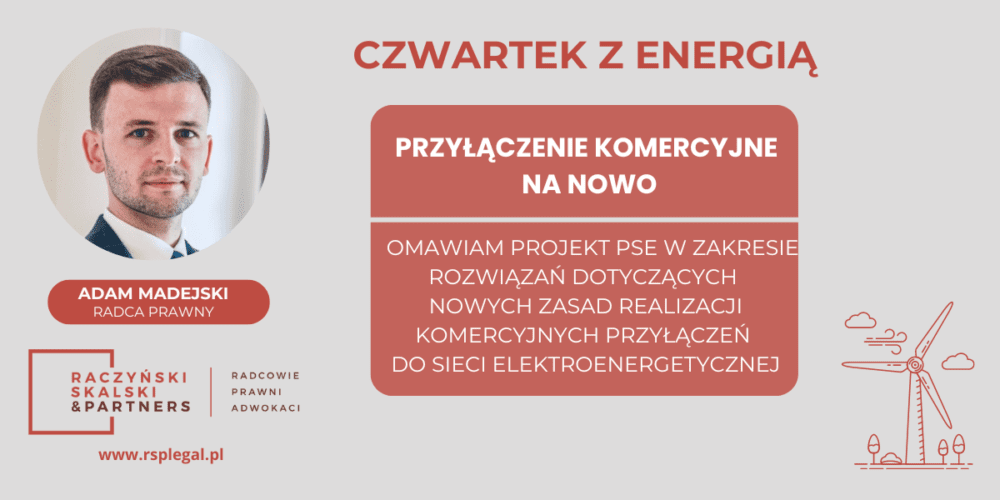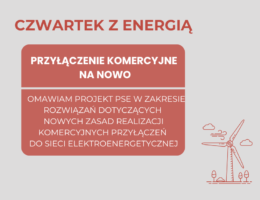The commercial mode of connection to the electricity grid is an emotionally charged issue. The dynamic growth of planned RES investments has caused an increasing number of investors to consider committing additional funds to implement their projects, thus completing grid extensions.
According to Article 7(9) of the Energy Law, the commercial mode is available when an investor is refused connection conditions due to a lack of economic conditions. Thus, it is worth looking into the subject of clarifying the rules for the implementation of commercial connection, which has so far functioned largely only on the basis of market practice.
1. Consultation of solutions in the field of commercial grid connection
The document published by Polskie Sieci Elektroenergetyczne S.A. proposes solutions for the rules of commercial grid connection implementation.
The first striking proposal is to structure the process of implementing commercial connections so that they have a more predictable character. As a first step, PSE proposes to separate 6 stages that would sequentially allow a clear framework for each project.
The first stage is to be a declaration on the part of the entity applying for connection regarding its intention to implement the project under the commercial mode. Such a declaration would be made within 30 days of either the refusal to issue connection conditions or the approval of commercial connection implementation conditions.
In this way, a list of projects subject to implementation under Article 7, paragraph 9 of the Energy Law is to be created.
The second stage is the selection of projects on a 3- to 6-month cycle. The result of this stage is to select projects in such a way that the related work allows for optimal development of the power grid and connection of new sources to the grid. PSE proposes to adopt the following criteria for project selection:
-
-
- Re-application for the issuance of connection conditions – for the elimination from the pool of projects for which public connection will be possible,
- No need to build a new extra-high voltage transformer station for which an investment decision has not yet been made – to determine a project with a smaller mandatory outlay,
- For the project, only the addition of a new field in an existing transformer station is required, without the need to expand the substation itself or acquire a new site,
- Implementation of the connection for the RES installation is possible in 48 months from the conclusion of the connection agreement – this is to ensure equal treatment of entities applying for the connection with respect to the public mode,
- Implementation of the project will not disturb or delay work already underway – this criterion is intended to protect investments already underway.
-
The third stage is to be the conclusion of an agreement with the operator and the execution of a network analysis. The subject of the network analysis is to be a detailed determination of the scope of necessary works and an estimate of their costs. The agreement, in turn, is to cover the division of work, as well as the rules for the investor to provide financial security.
The fourth stage is to be followed by a feasibility study and division of works. Based on the results of the network analysis, the parties will be able to move on to detailed arrangements of a design and technical nature to give the connection procedure a workable shape. The fourth stage is expected to result in a detailed scope of work in relation to the distribution network, agreement on the principles of cooperation between the DSO and the TSO, final pricing of the work, and the creation of a list of entities that, based on the results of the network analysis, uphold their declaration to carry out the connection in a commercial mode.
The fifth and sixth stages are the conclusion of contracts – for the expansion of the distribution network and the grid connection contract for a specific project.
The publication is available at: https://www.pse.pl/-/konsultacje-propozycji-rozwiazania-w-zakresie-przylaczania-do-sieci-na-zasadach-komercyjnych
2. Proposals for accompanying solutions
The move on the part of Polskie Sieci Elektroenergetyczne should be evaluated positively, but there are several issues that may be controversial or require clarification.
The first one that strikes the eye is the issue of performing a network analysis to determine the scope of the work and estimate its cost. These issues, it seems, are already examined as part of the process of applying for a grid connection, at the stage of the expert report referred to in Article 7(8e) of the Energy Law, as well as the implementation of the operator’s obligation referred to in Article 7(1)(2) of the Energy Law, ordering that the investor be informed of the estimated costs of implementing the connection on a commercial basis. In this regard, it would be appropriate to consider whether, in lieu of performing a new network analysis, given the time and financial outlay involved, an already prepared expert report could be adapted – in part or in whole.
Next, the content of the model agreement proposed in the consultation document contains a rather general set of rights and obligations, with particular emphasis on securing the financial aspects of carrying out work to connect a generating unit to the grid. It may be interesting to note the non-public content of Appendix No. 4 to this agreement under the title “Provisions of connection agreements for connection with limitations.” Given recent trends, it should be expected that the list will include regulations on redispatch and the generator’s lack of right to compensation due to the absence of a supply guarantee.
Finally, in my opinion, the issue related to the refusal of the transmission system operator to issue connection conditions and the possibility of a commercial mode with the distribution system operator needs to be clarified. This is because it may happen that connection to the transmission network is not possible for economic reasons due to the need to expand the distribution network. In such a case, with a view to saving costs, time and taking into account the position of the Court of Competition and Consumer Protection (XVII AmE 138/21), the investor should be entitled to implement the commercial mode directly with the distribution system operator. The ambiguous drafting of the provision of Article 7(9) of the Energy Law creates unnecessary barriers here, and this circumstance should be clarified as part of the consultation process.



